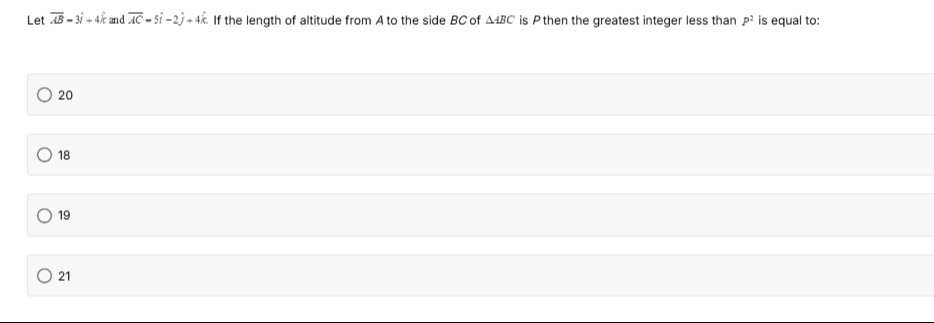Question
Question: Let $\overrightarrow{AB}=3\hat{i}+4\hat{k}$ and $\overrightarrow{AC}=5\hat{i}-2\hat{j}+4\hat{k}$. If...
Let AB=3i^+4k^ and AC=5i^−2j^+4k^. If the length of altitude from A to the side BC of △ABC is P then the greatest integer less than P2 is equal to:

A
20
B
18
C
19
D
21
Answer
20
Explanation
Solution
- Calculate the vector representing side BC: BC=AC−AB=(5i^−2j^+4k^)−(3i^+4k^)=2i^−2j^
- Calculate the square of the length of side BC: ∣BC∣2=(2)2+(−2)2+(0)2=4+4=8
- Calculate the cross product of AB and AC: AB×AC=i^35j^0−2k^44=i^(0−(−8))−j^(12−20)+k^(−6−0)=8i^+8j^−6k^
- Calculate the square of the magnitude of the cross product: ∣AB×AC∣2=(8)2+(8)2+(−6)2=64+64+36=164
- Relate the area of the triangle to the altitude: The area of △ABC is 21∣AB×AC∣. Also, Area =21×base×height=21∣BC∣P. Equating these gives: 21∣AB×AC∣=21∣BC∣P ∣AB×AC∣=∣BC∣P Squaring both sides: ∣AB×AC∣2=∣BC∣2P2
- Calculate P2: P2=∣BC∣2∣AB×AC∣2=8164=241=20.5
- Find the greatest integer less than P2: The greatest integer less than 20.5 is ⌊20.5⌋=20.
